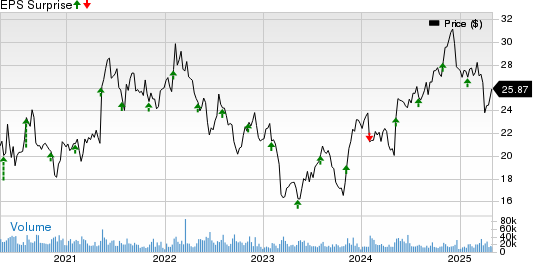Coffee Prices Increase as Supply Concerns Grow Globally
On Wednesday, July arabica coffee (KCN25) closed up +0.95 (+0.24%), while July ICE robusta coffee (RMN25) rose by +71 (+1.34%). Prices settled moderately higher, consolidating below the previous day’s highs. On Tuesday, arabica reached a 2-1/2 month high, and robusta achieved a 1-month high, fueled by worries over a smaller Brazilian coffee crop.
Predictions and Concerns for Brazilian Coffee Crop
Last Tuesday, Rabobank predicted that Brazil’s 2025/26 arabica coffee crop could drop by -13.6% year-over-year to 38.1 million bags, mainly due to dry conditions affecting key growing areas that hindered coffee trees’ flowering. In contrast, the robusta sector faces its own dynamics, as Rabobank forecasts a +7.3% increase in Brazil’s 2025/26 robusta coffee crop, potentially reaching a record 24.7 million bags.
Impact of Exports and Weather Conditions
Supply fears are bolstering coffee prices. On April 9, Cecafe indicated that Brazil’s March green coffee exports fell -26% from the previous year, totaling 2.95 million bags. Additionally, Conab, Brazil’s governmental crop forecasting agency, projected that the 2025/26 coffee crop will decrease -4.4% year-over-year to a three-year low of 51.81 million bags. Conab also revised its 2024 Brazil coffee crop estimate down by -1.1% to 54.2 million bags.
However, recent above-normal rainfall in Brazil is generating concerns as well. Somar Meteorologia reported that Minas Gerais, Brazil’s largest arabica-growing region, received 38.7 mm of rain in the week ending April 19—about 490% of the historical average. This situation could negatively impact coffee prices.
Mixed Supply Situation: Inventories Decline and Rise
Currently, the coffee supply landscape presents mixed signals. On Wednesday, ICE-monitored robusta coffee inventories fell to a four-month low of 4,225 lots. In contrast, arabica coffee inventories saw an increase, reaching a 2-1/2 month high of 826,304 bags on Monday.
Long-Term Weather Impacts on Production
The longer-term impact of last year’s dry El Niño weather could harm coffee crops in South and Central America. Brazil has faced its driest conditions since 1981, as recorded by Cemaden, making the flowering period critical for arabica crops at risk. Similarly, Colombia, the world’s second-largest arabica producer, is slowly recovering from a drought linked to the El Niño event.
Robusta Production Challenges in Vietnam
Robusta coffee is supported by falling production numbers. Due to drought, Vietnam’s coffee yield for the 2023/24 crop year plummeted by -20% to 1.472 million metric tons, marking the lowest output in four years. The Vietnam General Statistics Office also reported a -17.1% decline in 2024 coffee exports to 1.35 million metric tons. Additionally, the Vietnam Coffee and Cocoa Association lowered its 2024/25 coffee production estimate to 26.5 million bags, down from December’s estimate of 28 million bags. During January to March, Vietnam’s coffee exports decreased by -15.3% year-over-year, totaling 495,780 MT.
Global Coffee Export Trends
News of increased global coffee exports could weigh on prices. Conab reported a record +28.8% increase in Brazil’s 2024 coffee exports to 50.5 million bags. However, the International Coffee Organization (ICO) noted a -12.4% drop in global coffee exports in December year-over-year, totaling 10.73 million bags, with total exports from October to December down -0.8% year-over-year to 32.25 million bags.
USDA’s Outlook for Coffee Production
The USDA’s biannual report released on December 18 showed mixed signals for coffee prices. The USDA’s Foreign Agricultural Service (FAS) forecasted a +4.0% increase in world coffee production for 2024/25, totaling 174.855 million bags. This includes a +1.5% rise in arabica production to 97.845 million bags and a +7.5% boost in robusta production to 77.01 million bags. Ending stocks for 2024/25 are expected to diminish by -6.6% to a 25-year low of 20.867 million bags, compared to 22.347 million bags in the previous season.
Future Projections for Brazilian Coffee
For the 2025/26 marketing year, Volcafe has revised its Brazil arabica coffee production forecast to 34.4 million bags, roughly 11 million bags lower than the September estimate, reflecting the severity of ongoing drought conditions. Volcafe also predicts a global deficit in arabica coffee for 2025/26 of -8.5 million bags, larger than the -5.5 million bag deficit expected for 2024/25, marking the fifth consecutive year of deficits.
On the date of publication, Rich Asplund did not have positions in any of the securities mentioned in this article. All information and data in this article is solely for informational purposes. For more information, please view the Barchart Disclosure Policy.
More news from Barchart
The views and opinions expressed herein are the views and opinions of the author and do not necessarily reflect those of Nasdaq, Inc.
